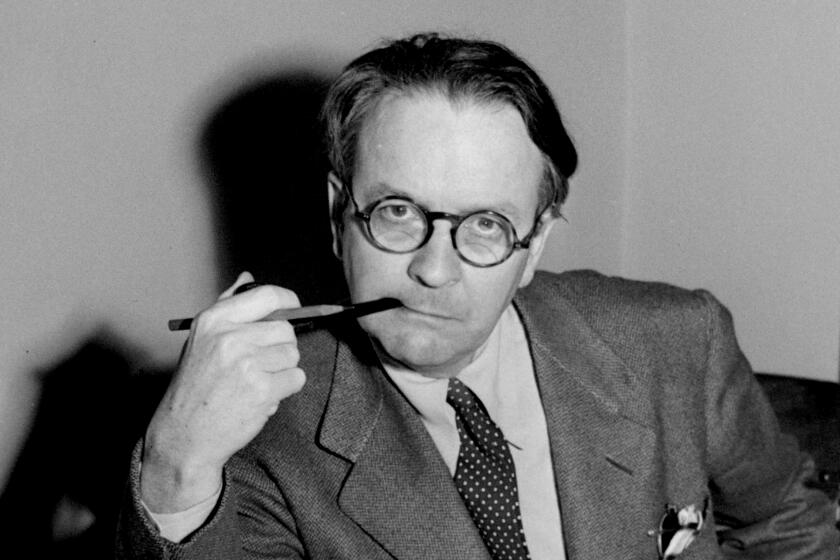William Faulkner: An Intruder in Hollywood’s Dust : Writing: Scholar Louis Daniel Brodsky has published the Pulitzer Prize winner’s powerful version of ‘Stallion Road,’ a script that was never filmed.
- Share via
William Faulkner’s troubled days as a Hollywood screenwriter, like those of F. Scott Fitzgerald, are occasionally cited as evidence of Hollywood’s cynical and ruinous treatment of great writers, exploited to do dreck instead of the literary masterworks they were capable of.
It seems true that Faulkner was exploitively underpaid, earning $300 a week when writers of lesser esteem were making $2,000 and directors two and three times that much. But there is also evidence that one or two of Faulkner’s immediate bosses at Warners were admiring of and patient with him during his dismaying bouts with the bottle.
It is also true that Faulkner’s finances were never less than catastrophic and that the movie work was a fiscal life-raft for him. Yet, also like Fitzgerald, Faulkner took screenwriting seriously and appreciated the power and the possibilities of the medium.
The young scholar-collector Louis Daniel Brodsky, in conjunction with the University Press of Mississippi, has published several volumes of Faulkneriana, a bibliography, letters, two earlier Faulkner scripts--”The De Gaulle Story” and “Battle Cry,” a collection of other manuscripts and treatments and now, decades after Faulkner wrote it, his version of “Stallion Road,” edited by Brodsky and Robert W. Hamblin (U. of Mississippi Press: $17.95).
The book includes a long scene-setting introduction by the editors and a remarkable free-swinging interview with Stephen Longstreet, who wrote the novel and whose own script of “Stallion Road” was the one that was finally shot in 1947, with Ronald Reagan, Alexis Smith and Zachary Scott as its principal stars.
Faulkner’s script of “Stallion Road,” Longstreet once told an interviewer, “was a magnificent thing, wild, wonderful, mad. Utterly impossible to be made into the trite movie of the period. Bill had kept little but the names and some of the situations of my novel and had gone off on a Faulknerian tour of his own despairs, passions and story-telling.”
To Brodsky, Longstreet confirmed his earlier assessment. “It was a little strong for then . . . a beaut, all shadow and highlights and with the smell of the best horses.” The novel is set at horse-breeding ranches on the Central California coast, with a dedicated young breeder working on an anti-anthrax serum and a headstrong nymphomaniac creating some intense sexual triangles.
In that era, of course, scripts were submitted to the Hays Code administrators for approval before shooting began. It was a censoring operation in the truest sense. The preliminary report on the Faulkner script by Joseph Breen, who ran the Code administration, is extracted in the introduction and is far from negative, although Breen made clear that the adultery would have to be handled very discretely. (The adulteress is killed, preserving the Code’s mandatory retribution for misdeeds.)
“Today,” Longstreet said in his earlier comments on the script, “it could be made as a New Wave film.” It could certainly be made as a Hollywood film now, with the steaming passions intact.
What is interesting about the script is the evidence that Faulkner had become a very good screenwriter. Adapting the sprawling novel, he dropped Longstreet’s narrator, combined characters to give the story more straight-line momentum. The script is relatively sparing on dialogue but generous with dramatic action which moves the story and illuminates the characters
Faulkner was in the end, Longstreet says, as good as any film writer working. Despite his self-made distractions, he was also uncommonly quick and productive, typing away through blinding hangovers and impatient with interruptions.
He had no doubt of his own gifts. “There are only three writers in America,” Longstreet remembers Faulkner saying: “Hemingway, myself, and Thomas Wolfe. . . . I’m the best.” Longstreet protested that Wolfe was a mess and a phony. “No. No,” Faulkner insisted. “Wolfe, Hemingway and myself are the three writers.”
Faulkner was unprintably unfond of Southern California. “One leaf falls in one of these canyons and they tell you it’s winter,” he complained to Longstreet.
Despite the success of two major films he collaborated on for Howard Hawks, “To Have and Have Not” and “The Big Sleep,” the frustrations of the screenwriter’s life got to Faulkner. Shortly after his script of “Stallion Road” was shelved in 1945, he went back home to Oxford, Miss. He worked for Hollywood only twice again, on “The Left Hand of God” and “Land of the Pharaohs” in the 1950s.
More to Read
Sign up for our Book Club newsletter
Get the latest news, events and more from the Los Angeles Times Book Club, and help us get L.A. reading and talking.
You may occasionally receive promotional content from the Los Angeles Times.








